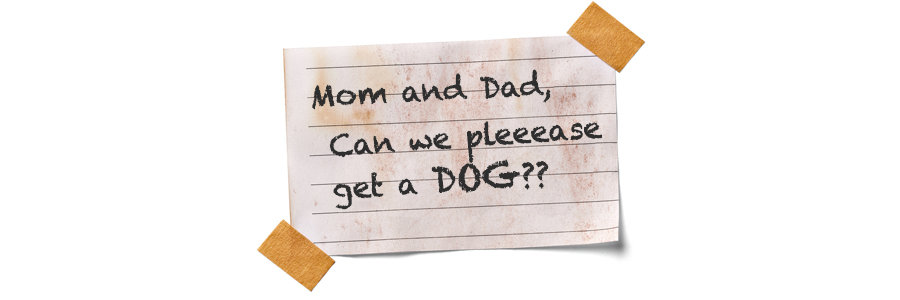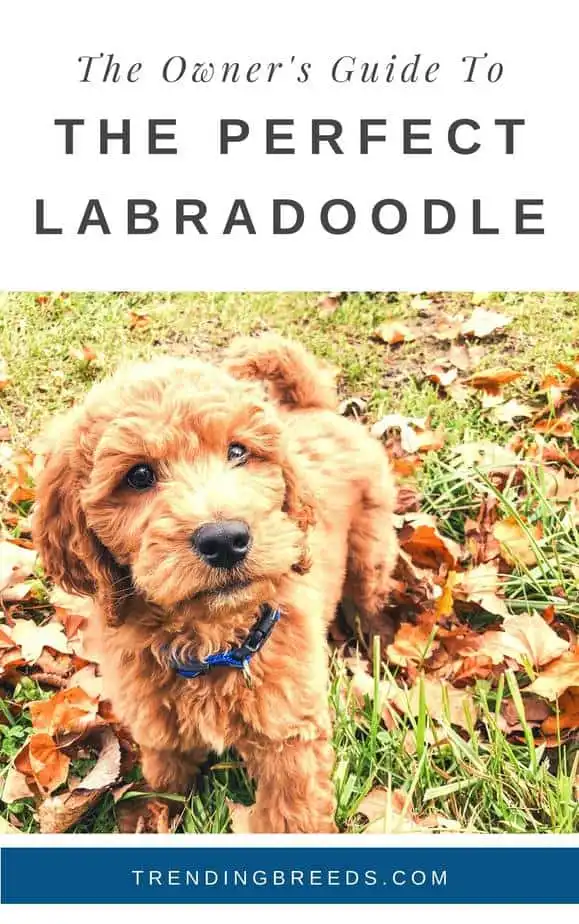
Owning a Labradoodle can be a fun and rewarding experience because this dog is intelligent, playful and affectionate.
They have the potential to have a relatively long life span and require maintenance and care.
It’s important to be aware of the costs associated with owning a Labradoodle prior to welcoming it into your home.
This is especially true with Labradoodles because they are fairly large dogs that require not only maintenance but are also dogs that generally live many years.
If someone asked you to make a checklist of possible costs you’d incur by owning a Labradoodle, you might say dog food, annual shots and checkup, dog brush and crate.
While you may be off to a good start, these are just a few things you’ll need for your Labradoodle.
To get a more realistic idea, we’ll make a little list and then break it down.
- Dog Food – This includes not just dog food but also treats. You really can’t own a dog and not give them treats. This can include bought or homemade treats.
- Annual checkup – This consists of an office visit for a yearly checkup and any required vaccinations. However, what if your dog gets injured or sick?
- Dog Brush – The Labradoodle’s long wavy hair does require daily brushing. You will need more than one brush throughout the dog’s life.
- Dog Crate – Even if you plan on having your Labradoodle sleep with or near you, you’ll probably still want a dog crate for certain times.
The above items are just a start of what you can expect when you own a Labradoodle. This list is not meant to deter you but rather to prepare you for Labradoodle ownership.
I’m speaking from experience here – I own two of these amazing dogs!
In fact, if you’re seriously considering getting a Labradoodle, definitely pick up a copy of my Labradoodle book, The Owner’s Guide To The Perfect Labradoodle.
In addition to my personal experience with the breed and what to expect as far as temperament, size, and coat are concerned, you’ll find tips on:
- Selecting and working with a breeder.
- Puppy proofing your home.
- Exercise and mental stimulation.
- Socialization.
- Housebreaking and training.
- Perfect toys and recommended grooming supplies.
- Shedding and daily grooming basics.
- And much, much more!
All this at your fingertips, because questions will arise – that’s just part of owning a dog. Having the answers there when you need them in an easy-to-read guide is truly invaluable.
Now we’ll break the list down even more by providing you with 11 costs associated with owning a Labradoodle.
As an owner of 2 Labradoodles myself, I know how tough it can be to find good information. In the 60+ pages of this book, I share the information, resources, and breed-specific tips I wish I’d had from the start. You will save you time, money, and loads of frustration…take my word for it!
1. Vet Visits And Check-ups
When you first bring your Labradoodle puppy home, visits to the vet are probably the furthest thing from your mind.
Unfortunately, they are a real and very important part of having a happy, healthy dog.
As soon as you bring your Labradoodle puppy home, you should schedule an appointment with your vet for a checkup.
Although most reputable breeders will tell you the puppies are healthy, it’s important to have the pup checked by a vet.
If you don’t have a vet, do some research or talk to friends who have pets.
Your veterinarian is a professional who will be treating your beloved pet for many years, so you want to find a reliable and reputable veterinarian.
Most veterinarians recommend bringing the dog in at least once a year for a wellness exam.
A wellness exam can often detect an issue in its early stages and help maintain good health for your Labradoodle.
If your Labradoodle has no visible or apparent issues, this visit should be relatively inexpensive. However, this depends on how thorough the vet wants to be.
Once the dog reaches the age of seven, the vet may want to see him or her twice a year because this is the age where issues can begin developing.
Some wellness exams involve nothing more than the vet checking the dog’s ears and teeth and listening to its heart.
In some cases, the vet may do blood work, a urinalysis and take an x-ray.
Simple wellness exam – $50; X-ray; urinalysis and blood work – $150 – $250
2. Spay/Neutering
Spaying or neutering you Labradoodle is essential to prevent unwanted breeding.
With a large number of healthy puppies and adult dogs euthanized every year, most vets strongly recommend having your dog spayed or neutered.
For many years, there have been myths involving sterilization of dogs. One misconception is that dogs gain a lot of weight after they’re spayed or neutered.
With a good diet and exercise, there is no reason why your Labradoodle should gain a lot of weight.
Another myth is that spaying or neutering a dog will correct or eliminate bad behavior.
While it is true that unneutered male dogs tend to be more aggressive towards other intact male dogs, most of the issues can be remedied with consistent training.
There are many health benefits to spaying your female dog. Unspayed dogs are at a much higher risk of developing cancer and uterine infections.
Additionally, unless you’re a professional breeder, there isn’t a good reason to not neuter or spay your dog.
The cost for spaying or neutering your Labradoodle will depend on who does the surgery. Many vets require the dog to spend the night at the clinic after the surgery.
This can add another $100 to the sterilization fee. Sterilization fees are usually higher for a large dog because there is more work and anesthesia involved.
Total Cost for Spaying or Neutering – $200 to $400
3. Shots And Vaccinations
In addition to annual checkups, your Labradoodle should follow a regimen of scheduled shots and vaccinations.
The American Animal Hospital Association recommends that all puppies get their first vaccination at six weeks of age and every two to four weeks after that until the age of 16 weeks.
After that time the dog should get vaccinations once a year or every three years depending on the shot. This annual vaccination usually consists of the following:
- Canine Distemper
- Adenovirus 2
- Parainfluenza Virus
- Canine Parvovirus
It’s also important to give your Labradoodle medication to prevent or remove worms, which can make the dog sick.
As per state law, dogs are required to have a rabies shot. The first rabies shot is good for a year, and the following rabies shots are good for three years.
Most vets recommend that dogs get medication to prevent heartworm as well as medication for flea and tick control.
Dogs that live in areas where ticks are prevalent should have a shot for Lyme’s disease as well.
Depending on the area in which the Labradoodle lives, the vet may also recommend vaccinating the dog against Bordetella (kennel cough) and leptospirosis.
The cost of these shots can vary depending on the veterinarian.
Most vets will also tack on a fee for the office visit. Labradoodle owners should be prepared to spend the following amounts annually.
- Annual vaccination – $45
- Rabies shot – $25
- Bordetella/Leptospirosis – $30 per shot
- Lymes Disease – $40
- Heartworm – $125
- Flea & tick control – $100
Total approximate annual cost – $395
4. Food And Treats
Food for your dog may not be the most expensive cost associated with owning a Labradoodle, but it’s definitely a cost that can add up over the life of the dog.
The type of dog food you feed your Labradoodle depends a lot on the size of your dog, and this usually stems from the type of poodle the Labrador was bred with.
Whatever brand or type of dog food you choose to buy for your Labradoodle, it should be top-quality dog food.
A medium-sized Labradoodle can get adult dog food while a large dog will do well with a large breed formula.
During the first year of your Labradoodle’s life, he or she should get food designed for puppies.
It can be difficult to decide between top brands and decipher ingredient labels accurately.
We have an extremely informative guide to choosing the best dog food that will help you make the best choice.
Labrador Retrievers and Poodles are both prone to food allergies, so you may want to keep them on a grain-free diet.
The most common ingredients that can trigger dog allergies are wheat, soy or corn.
Some good choices of dry dog food, many of which include fruits and vegetables in the ingredients, include:
- Venison
- Roasted Bison
- Salmon
- Duck
- Lamb
You may want to offer treats as part of your training routine, to reward good behavior or just because you love your four-legged friend.
The important thing is to give your Labradoodle healthy snacks and not make them a large part of their daily diet.
In fact, WebMD recommends that dog treats not make up more than 10% of your dog’s daily diet. Snacks may include easy-to-chew snacks or smaller moist treats.
If the treat is designed to keep your Labradoodle occupied and happy for a long time, you might want to get some antlers or bully sticks.
Although rawhide chews have been popular choices for years, they should be avoided because they can raise havoc with a dog’s digestive system.
Annual cost for dog food – $480 @ $40 per bag; Annual cost for treats – $125
5. Collar And Leash
Collars and leashes are probably the first supplies you’ll buy for your Labradoodle.
You’ll want a collar on the dog all the time and a leash for when you go for daily walks or during training.
You’ll be able to choose from a variety of collars, including fabric, leather, vinyl or chain.
The most common type is a basic nylon/polyester adjustable collar with a metal leash loop and a plastic snap closure. Most owners find these the best because:
- They’re adjustable.
- They’re comfortable.
- They don’t snag on the dog’s fur.
- They have the loop for the dog’s ID tag.
- They’re available in illumination or reflective styles.
Like collars, leashes are also available in different styles, colors, fabrics and designs.
You’ll want a shorter leash (four feet or less) for walking the dog and a longer one for training. Avoid retractable leashes because they can be hazardous on walks.
The bottom line is that you’ll probably experiment until you find one that’s comfortable for you and your dog.
Cost for Collar – $10 each; Cost for Leash $10 each
6. Crate
If you’ve never had a dog crate for your dog, you’ll never understand how important they can be.
- They allow you to keep your dog confined while traveling.
- They’re invaluable and essential for crate training a puppy.
- They’re perfect for confining the puppy when left home for short periods.
- They give the dog his or her own “space”.
- They’re a place the dog can relax, take and chew a bone or take a nap.
While a puppy should be in a small crate, larger dogs should have a crate large enough so he or she can lay comfortably.
Dog crates are usually heavy-duty plastic or metal. Some are also foldable.
To avoid having to buy multiple crates as your pup grow, consider getting a crate that will fit them once they’re full-grown and a divider to limit its size when they’re small.
Check out our favorite crate and reasons why we love it!
Cost for Crate -$50 to $250
7. Shampoo And Conditioner
Finding the right shampoo may seem daunting when you see all the different brands and types of shampoo available.
Labradoodles have long curly hair that results in a beautiful coat.
You want to get a good conditioner for your dog so you’ll have an easier time combing through the dog’s hair. Your Labradoodle will appreciate the effort.
Personally, I tried many products before settling on my favorite dog shampoo.
It not only smells amazing, but it also is totally free of things I don’t want to use on my dog, like soap, phalates, sulfates, and parabens.
After shampooing, I use this conditioner to add a nice shine to the coat and make tangles practically nonexistent.
There are also many good 2-in-1 (shampoo and conditioner) products on the market. These are very good as well. Natural shampoos are also very good.
Cost – Shampoo: $10 a bottle, Conditioner: $10 to $20 a bottle
8. Brushes And Combs
Your Labradoodle has a long curly coat that may not always be easier to comb through or manage, but grooming is essential.
Having the right kind of brush can make all the difference to you and the dog.
Without the right brush, you’ll be pulling and trying to force the bristles through the hair, which will make for an uncomfortable experience for you and your dog.
You may find that taking your Labradoodle to the groomer for a haircut every month or so will make brushing much easier for you.
Because they get matted so easily, Labradoodles should be brushed 1 to 3 times per week.
Depending on the type of coat your Labradoodle has, you may find the following brushes helpful.
- Ergonomic Slicker Brush – has metal bristles that get through snags right to the skin.
- Li’l Pals Bristle Brush – has soft bristles ideal for smaller Labradoodles.
- Stainless Steel Grooming Comb – ideal for getting out snarls and massaging the skin.
- Undercoat Rake – Perfect for removing mats or thinning out hair.
Cost for Brushes – $10 to $25 each
9. Obedience Training
As a new Labradoodle owner, you may want to do most of the training yourself. It’s a great bonding experience, and it’s a way to show your dog what you expect of him or her.
Because these dogs are so intelligent and eager to please, training is typically quite easy.
However, if you don’t have the interest, time, or knowledge to train your Labradoodle, you can take the dog to a professional trainer.
The amount of time or money you’ll spend with a trainer will depend on the level of training you want for the dog.
Some dog trainers charge a flat fee and allow the dog and owner to come to future sessions free of charge for six months to a year.
Most dog owners start with basic obedience training, which teaches the dog the following commands:
- Sit
- Down
- Stay
- Come
- Leave it
- Heel
Cost of Basic Obedience Training – $200 to $500
10. Dog Walker
Other than getting treats, there are few things your Labradoodle will enjoy more than going for a walk with you.
However, if you have a busy schedule or work odd hours and can’t take him or her out for a walk regularly, you may want to hire a dog walker.
This ensures that your Labradoodle gets all the exercise and fresh air he or she needs to be healthy and happy. (How much exercise do they need? Find out here.)
Professional walkers will walk your dog when and how long you request and usually charge per hour or for a 20-minute period.
Cost for Dog Walker – $15 to $30 for 20 to 30-minute walk
11. Professional Grooming
If you do all your dog’s grooming, you’ll save a bundle of money with the only cost being shampoo, conditioner, and brushes (and you’ll need some good clippers and grooming shears).
You can see what I personally recommend (and use myself) in this grooming article.
Unfortunately, not everyone is lucky enough to have the time or patience to groom their Labradoodle every time.
Professional groomers do an excellent job of cleaning and sprucing up your Labradoodles. They bathe them, brush them, clean their ears, and clip their nails.
To many Labradoodle owners, it’s a monthly expense they’re more than happy to pay.
Cost for Grooming (bath plus brushing) $30 to $50; Cost for nail clipping – $10
Related Questions:
How often should I bathe my Labradoodle?
Despite the Labradoodle’s wooly, curly coat needing occasional brushing, they don’t need bathing very much.
Their somewhat water-repellent coats contain natural oils and stay reasonably clean. Bathing too often can strip them of these essential oils.
If they happen to get into some mud, it’s easier to let them dry and then brush it out.
A good rule of thumb is not to bathe your Labradoodle more than once a month. But if you must, make sure you’re using a quality conditioner to replenish their coats moisture.
I can’t recommend this conditioner/detangler enough. Tangles are no longer an issue, it can be used on a wet or dry coat, and a tiny bit goes a long way.
How do I get my Labradoodle to enjoy being brushed instead of fighting me?
Labradoodles love attention! If your Labradoodle doesn’t enjoy being brushed, he or she may have had a bad experience.
Brushing the dog regularly from a young age will get them used to the routine. Be gentle and brush softly for short periods.
Giving the Labradoodle a treat after the grooming session should make him or her associate brushing with a positive experience.
Why should I take my Labradoodle to the vet if he or she is not sick?
Nobody enjoys going to the vet needlessly and paying an unnecessary vet bill.
However, if there is a health issue starting, it’s usually more beneficial and less costly to catch it in its early stage when it may be corrected.
We Hope That Helps!
Bringing a Labradoodle puppy, or any new puppy for that matter, into our home and lives can be an extremely exciting time.
They’re playful, loving, affectionate, and most everything they do is cute.
Unfortunately, we don’t often think past the initial excitement of getting a puppy to stop and consider the work and expense that goes along with dog ownership.
It’s important to realize the cost involved not just the first year but throughout the dog’s life.
Other than loving your Labradoodle, taking good care of him or her is the best thing you can do for the dog.
Before you go, don’t forget to check out The Owner’s Guide To The Perfect Labradoodle – a must-have for every Labradoodle owner!





